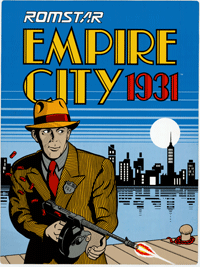Empire City: 1931
| Empire City: 1931 | |
|---|---|
 Arcade cabinet side art | |
| Developer(s) | Seibu Kaihatsu[4] |
| Publisher(s) | Arcade Family Computer/MSX Toshiba EMI[4] |
| Producer(s) | Hitoshi Hamada |
| Platform(s) | Arcade Family Computer MSX |
| Release | Arcade Family Computer MSX
|
| Genre(s) | Shooter |
| Mode(s) | Single-player, two-player[6] |
Empire City: 1931[a] (known as Street Fight in Germany and the Benelux Union) is a shooter game developed by Seibu Kaihatsu that was originally released into arcades in 1986, by Taito in Japan and Europe and by Romstar in North America. The game has players taking on the mafia in 1931 New York City by gunning down mobsters one by one.
Versions of the game were released for the Family Computer (1987) and MSX (1988) as Magnum Kiki Ippatsu: Empire City 1931.[b][7] Acclaim advertised a release for the Nintendo Entertainment System in Western regions, but the console version remained exclusive to Japan.[8]
Seibu Kaihatsu eventually released a follow-up game, Dead Angle.
Gameplay
[edit]
The game is set in 1931 New York City where the player controls a young FBI agent who is out to avenge his family members, who were killed in a gang shootout. Over a period of several months, he targets mobsters, culminating with the mafia boss.
Players use a joystick to move a crosshair around the screen to aim and shoot at mobsters one at a time. They lurk around various areas, including on the street and in windows. An arrow appears that helps direct players to the location of the next mobster onscreen. Players have a set amount of time to find and shoot each enemy; if time is running out, a speech bubble appears counting down the last few seconds on the timer. When the timer reaches zero, the player is shot and the screen pans to the location of the enemy. A defend button is available as a last resort to avoid being shot.[2] Players can replenish their ammo by shooting hidden ammunition boxes and get bonus points by shooting at gold bars.
Levels are cleared after a set number of mobsters are eliminated. In the game's final level, the player has only one opportunity to assassinate the mob boss as he walks in front of windows in a building. After the final level is completed, the game loops back to the beginning.
The Famicom version is largely the same.[9] The player's progress can be restored any time in the Famicom version by using a password system of four numbers and/or letters.
Reception
[edit]In Japan, Game Machine listed Empire City: 1931 on their August 1, 1986 issue as being the fourth most-successful table arcade unit of the month.[10]
A review by Clare Edgeley in Computer and Video Games said the game was "fast moving, with lots of action" and called it an "unusual and addictive game" that was "bound to be a winner".[2]
Notes
[edit]References
[edit]- ^ a b Akagi, Masumi (October 13, 2006). アーケードTVゲームリスト国内•海外編(1971–2005) [Arcade TV Game List: Domestic • Overseas Edition (1971–2005)] (in Japanese). Japan: Amusement News Agency. pp. 136–7. ISBN 978-4990251215.
- ^ a b c Edgeley, Clare (15 June 1986). "Arcade Action: Empire City". Computer + Video Games. No. 57 (July 1986). p. 94.
- ^ https://www.famitsu.com/games/t/20238/
- ^ a b Magnum Kiki Ippatsu: Empire City 1931 at MobyGames
- ^ "Video Game Flyers: Empire City". The Arcade Flyer Archive. Retrieved 11 August 2021.
- ^ # of players information at Arcade Museum
- ^ Japanese title information at SuperFamicom.org
- ^ Cifaldi, Frank (Nov 10, 2009). "The Paper Trail: VideoGames & Computer Entertainment #1". Retronauts. 1up.com. Archived from the original on July 9, 2012. Retrieved July 31, 2012.
- ^ Magnum Kiki Ippatsu: Empire City 1931 Archived 2008-07-25 at the Wayback Machine at Manna Revolver Knight
- ^ "Game Machine's Best Hit Games 25 - テーブル型TVゲーム機 (Table Videos)". Game Machine (in Japanese). No. 289. Amusement Press, Inc. 1 August 1986. p. 25.
External links
[edit]- Empire City: 1931 can be played for free in the browser at the Internet Archive
- 1986 video games
- Arcade Archives games
- Arcade video games
- Hamster Corporation games
- MSX games
- Multiplayer and single-player video games
- Nintendo Entertainment System games
- Nintendo Switch games
- Organized crime video games
- PlayStation 4 games
- Romstar games
- Seibu Kaihatsu games
- Shoot 'em ups
- Taito arcade games
- Video games about police officers
- Video games developed in Japan
- Video games set in 1931
- Video games set in New York City
